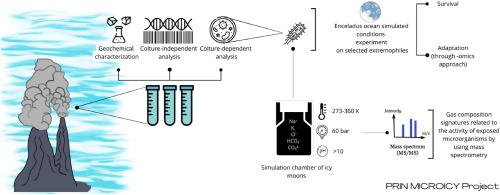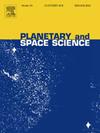模拟冰冷月球环境下的微生物:支持太阳系探索(MICRO ICY项目)
IF 1.7
4区 物理与天体物理
Q3 ASTRONOMY & ASTROPHYSICS
引用次数: 0
摘要
对太阳系冰冷卫星的探索标志着寻找外星生命的新篇章,下一代任务将瞄准这些有希望的环境。卡西尼号对土卫二的飞掠揭示了一个包含有机化合物和生物可用氮的全球地下海洋,这表明了我们所知道的生命的潜在条件。其他有地下海洋的卫星,如木卫二、土卫六、木卫三和木卫四,现在被认为在宇宙中比以前认为的更普遍。因此,土卫二为推进天体生物学研究和技术提供了一个重要的平台。考虑到空间探索的挑战,基于地球的(现场和实验室)实验对于解释远程数据和了解冰月过程至关重要。与土卫二类似的陆地热液地点,揭示了生命的起源和保存,扩展了我们对宜居概念的认识。在这些环境中繁衍生息的极端微生物使生命的界限变得更加清晰,并为在其他地方寻找生命提供了支持。在此背景下,MICROICY项目旨在:(i)研究冰岛Strýtan碱性浅水热液喷口(类似于土卫二的热液喷口)中的微生物群落;(ii)评估极端微生物在类似土卫二条件下的适应机制;以及(iii)使用质谱检测器检测微生物活性的气体生物特征。这些发现将支持在下一代天体生物学任务中使用气体生物特征,推进对土卫二和其他冰冷卫星的探索。本文章由计算机程序翻译,如有差异,请以英文原文为准。

MICROorganisms under simulated ICY moon environments: supporting solar system exploration (MICRO ICY project)
The exploration of icy moons in the solar system marks a new chapter in the search for extraterrestrial life, with next-generation missions targeting these promising environments. Cassini's flybys of Enceladus revealed a global subsurface ocean containing organic compounds and biologically available nitrogen, suggesting potential conditions for life as we know it. Other moons with subsurface oceans, such as Europa, Titan, Ganymede, and Callisto, are now considered more common in the cosmos than once believed. Enceladus thus provides a critical platform for advancing astrobiological research and technology.
Given the challenges of space exploration, Earth-based (both in-situ and laboratory) experiments are crucial for interpreting remote data and understanding icy moon processes. Terrestrial hydrothermal sites, similar to those expected on Enceladus, shed light on the origins and preservation of life, expanding our knowledge of the habitability concept. Microbial extremophiles thriving in these environments allow to refine life's boundaries and support the search for life elsewhere.
In this context, the MICROICY project aims to: (i) study microbial communities in the Strýtan alkaline shallow-water hydrothermal vents in Iceland, analogues to Enceladus' hydrothermal vents; (ii) assess the adaptation mechanisms of extremophiles under Enceladus-like conditions; and (iii) detect gas biosignatures of microbial activity using a mass spectrometry detector. These findings will support the use of gas biosignatures in next-generation astrobiology missions, advancing the exploration of Enceladus and other icy moons.
求助全文
通过发布文献求助,成功后即可免费获取论文全文。
去求助
来源期刊

Planetary and Space Science
地学天文-天文与天体物理
CiteScore
5.40
自引率
4.20%
发文量
126
审稿时长
15 weeks
期刊介绍:
Planetary and Space Science publishes original articles as well as short communications (letters). Ground-based and space-borne instrumentation and laboratory simulation of solar system processes are included. The following fields of planetary and solar system research are covered:
• Celestial mechanics, including dynamical evolution of the solar system, gravitational captures and resonances, relativistic effects, tracking and dynamics
• Cosmochemistry and origin, including all aspects of the formation and initial physical and chemical evolution of the solar system
• Terrestrial planets and satellites, including the physics of the interiors, geology and morphology of the surfaces, tectonics, mineralogy and dating
• Outer planets and satellites, including formation and evolution, remote sensing at all wavelengths and in situ measurements
• Planetary atmospheres, including formation and evolution, circulation and meteorology, boundary layers, remote sensing and laboratory simulation
• Planetary magnetospheres and ionospheres, including origin of magnetic fields, magnetospheric plasma and radiation belts, and their interaction with the sun, the solar wind and satellites
• Small bodies, dust and rings, including asteroids, comets and zodiacal light and their interaction with the solar radiation and the solar wind
• Exobiology, including origin of life, detection of planetary ecosystems and pre-biological phenomena in the solar system and laboratory simulations
• Extrasolar systems, including the detection and/or the detectability of exoplanets and planetary systems, their formation and evolution, the physical and chemical properties of the exoplanets
• History of planetary and space research
 求助内容:
求助内容: 应助结果提醒方式:
应助结果提醒方式:


